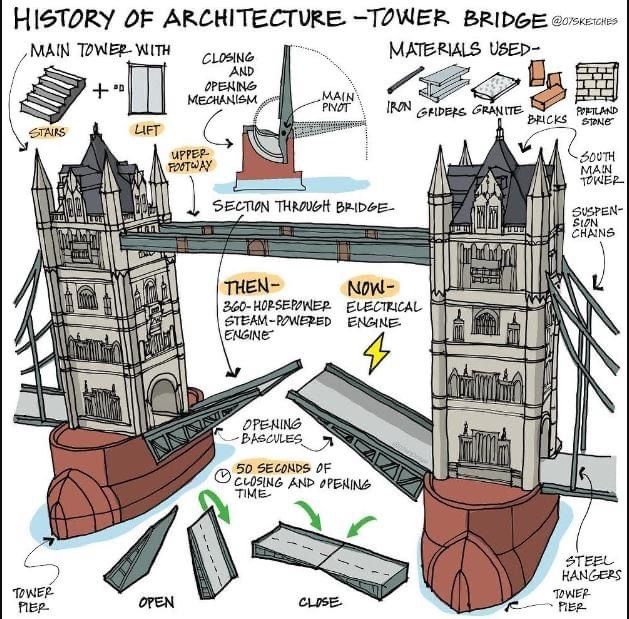From steam-powered engines to modern electrical systems, Tower Bridge remains a living monument of Victorian innovation—uniting function, beauty, and history across the River Thames.
In the heart of London, arching gracefully over the River Thames, stands Tower Bridge, one of the most recognizable landmarks in the world. With its twin Gothic towers and iconic bascule lifting system, Tower Bridge is more than just a passage across the river—it is a masterpiece of Victorian engineering and architecture. Since its completion in 1894, the bridge has symbolized the fusion of tradition and innovation, blending medieval-inspired design with cutting-edge 19th-century mechanics.
Today, more than 130 years later, Tower Bridge continues to captivate millions of visitors, proving that great architecture is not only built for utility but also for cultural identity.
⚙️ Engineering Genius: Then and Now
🔥 The Steam Age
When Tower Bridge first opened, it was powered by a 360-horsepower steam engine—a marvel of its time. The bridge was designed to allow tall ships to pass through the busy docks of Victorian London. Its bascule system, which lifts the central sections of the bridge, was operated by steam-powered hydraulics. The sheer scale of this engineering feat was astonishing: two massive roadways could be lifted within minutes, giving ships safe passage while maintaining London’s traffic flow.
⚡ The Electrical Revolution
In the 1970s, the system underwent a major transformation. The old steam engines were replaced with a modern electrical system, making operations faster and more efficient. Today, the bridge’s bascule leaves can open and close in about 50 seconds, accommodating both river and road traffic with seamless precision. Yet, despite modernization, the original steam engines are preserved and displayed as part of the Tower Bridge Exhibition, connecting the present to its industrial past.
🏗️ Architectural Elegance
Tower Bridge was never meant to be just a functional structure; it was designed to complement the nearby Tower of London, a UNESCO World Heritage site. Architect Sir Horace Jones, in collaboration with engineer Sir John Wolfe Barry, envisioned a structure that combined Gothic Revival architecture with cutting-edge mechanics.
The bridge features:
- Twin towers built on massive piers, housing staircases and lifts.
- Suspension chains and steel hangers that support the roadways.
- Granite and Portland stone cladding, chosen to harmonize with the historic skyline.
- Upper walkways, originally intended for pedestrians to cross when the bascules were raised, now offering panoramic views of London.
🧱 Materials That Shaped a Legend
The construction of Tower Bridge required a blend of strength and beauty. The main structural framework used steel girders—a symbol of Victorian industrial power. To ensure visual harmony with the historic Tower of London, the steel skeleton was clad in granite and Portland stone, materials that not only provided durability but also gave the bridge its distinguished Gothic aesthetic.
Over 11,000 tons of steel were used in its framework, demonstrating the immense scale and ambition behind its construction.
🚢 Function Meets City Life
Tower Bridge was designed with a unique challenge: how to allow large sailing ships to access the docks upriver while maintaining a vital road crossing. The bascule design, sometimes called a “drawbridge,” was the solution. Each side of the central roadway could pivot upward, creating a wide opening for vessels.
This practical function continues today. The bridge is raised more than 800 times a year, primarily for tall ships and river traffic, delighting crowds of tourists who gather to watch the spectacular sight.
🕰️ A Timeline of Legacy
- 1886: Construction of Tower Bridge begins.
- 1894: The bridge officially opens, after eight years of work involving 432 construction workers.
- 1894–1976: Operated by steam-powered hydraulics.
- 1976: Transition to an electrical system.
- 1982: The high-level walkways reopen as part of the Tower Bridge Exhibition.
- Present day: Tower Bridge is both a working road and pedestrian crossing and a global tourist attraction.
🌍 Global Symbol of London
Much like the Eiffel Tower in Paris or the Statue of Liberty in New York, Tower Bridge is more than just infrastructure—it is a cultural symbol. It has appeared in countless films, books, and artworks, from Sherlock Holmes adventures to Harry Potter films. Its instantly recognizable form is often mistaken for London Bridge, a confusion that has ironically made it even more famous.
Tower Bridge is not merely admired for its looks; it embodies the spirit of a city that thrives on innovation, resilience, and grandeur.
🎟️ The Visitor Experience
Today, Tower Bridge is one of London’s most visited attractions. The Tower Bridge Exhibition allows visitors to explore:
- The Victorian Engine Rooms, where the original steam engines are preserved.
- The Glass Walkways, offering a thrilling view of the Thames 42 meters below.
- Interactive exhibits explaining the history of the bridge and its role in London’s growth.
For locals, it remains a vital part of the city’s transport network, carrying thousands of vehicles and pedestrians daily.
📜 Conclusion
Tower Bridge is more than an architectural marvel; it is a story of innovation meeting tradition. From the roar of steam engines to the hum of modern electrics, the bridge has evolved without losing its charm or historical value. It stands as a reminder that true engineering genius lies not only in solving problems but in creating enduring beauty.
In a city where ancient history and modern skyscrapers coexist, Tower Bridge continues to be London’s proud symbol—a bridge not just across a river, but across time itself.
